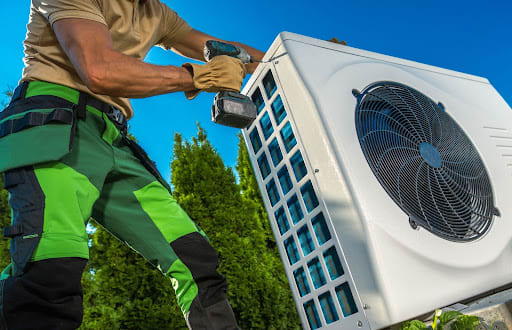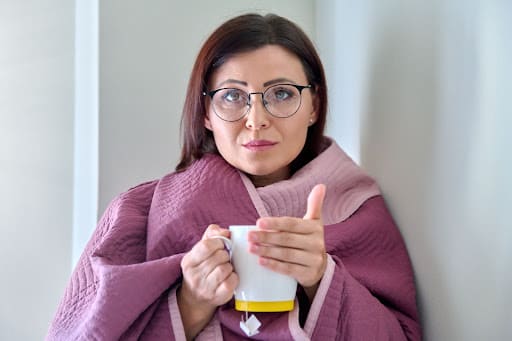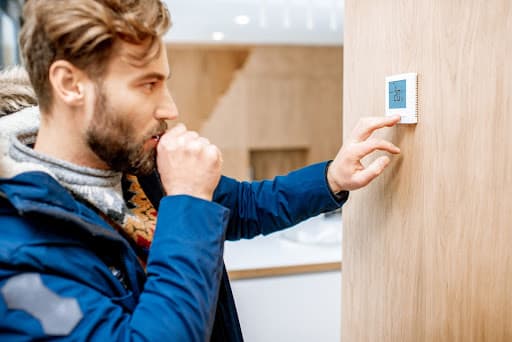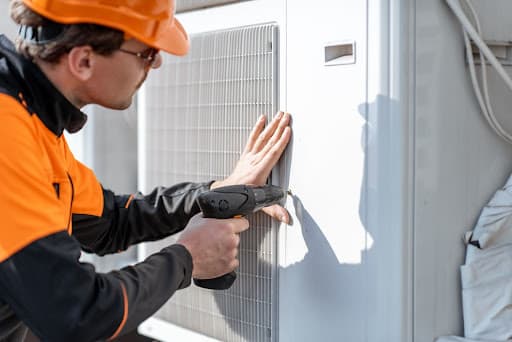
Have you ever wondered what that blinking “AUX” means on your thermostat’s display? You may have wondered if anyone in your household has messed with the settings, but this feature has started on its own! AUX stands for auxiliary heat, and it’s entirely normal for it to kick on occasionally, especially in frigid Minneapolis winters. However, it’s still important to know what auxiliary heat is to identify operational issues if they arise. Here’s everything you need to know about auxiliary heat on your thermostat.
What is auxiliary heat?
Auxiliary heat is a secondary heating setting on your home thermostat. It automatically turns on when your primary heating method can’t heat your home correctly. For example, the auxiliary heat will likely kick over when it’s too cold outside for your heat pump to extract warm air from the outdoors effectively. So instead of using outside air to heat your home, your heating system uses heat strips to create auxiliary heat.

Why is my auxiliary heat on?
There may be a few reasons your auxiliary heating system is turned on. Take a look over these the four top things that trigger auxiliary heating:
- Below-freezing temperatures. It’s typical for below-freezing temperatures outside to trigger auxiliary heating. Auxiliary heat will turn on for a short time to ensure your home stays cozy in frigid temperatures when your heating pump can’t keep up with the demand.
- Frost, ice, or snow on the heat pump. Auxiliary heat protects your system from layers of ice or snow in the winter. When your heat pump can’t function due to being covered in ice, the auxiliary heat will turn on to keep your home warm. Then, hot refrigerant will be sent to your heat pump to defrost the system. Once the auxiliary heat thaws your heat pump and coils, it will turn off, and the heat pump will resume as normal.
- Low refrigerant levels. Your auxiliary heat may also turn on due to low refrigerant levels. Refrigerant helps the heat pump coils absorb heat to warm the air, but when your system is low on refrigerant, it can’t heat your home appropriately. There are two signs that your heat pump may be low on refrigerant. First, it consistently ices over. Second, your home heating might be less efficient than expected. In these cases, always check refrigerant levels before calling a technician.
- Malfunctioning fans. The last reason your auxiliary heat is switched on is that your heat pump fans aren’t working properly. This situation may be a quick fix or require the help of an HVAC technician. First, check if anything is preventing the fans from rotating. Sometimes, sticks or pinecones might block the blades from moving. If not, the motor may fail and require a replacement soon.

Is it bad if the auxiliary heat comes on?
No, it isn’t bad if your auxiliary heat turns on. It’s a temporary, built-in function to ensure your home stays warm even in severe freezing temperatures. However, if your auxiliary heat turns on repeatedly or doesn’t shut off, there may be an underlying problem. In this case, we recommend contacting your local HVAC technicians to check your heating system.
Is auxiliary heat the same as emergency heat?
Not necessarily– there are a few differences between auxiliary heat and emergency heat. While they work closely with each other, they have different functions.
Auxiliary heat comes on automatically when your heat pump can’t produce heat sufficiently. It triggers the secondary heating method, radiant heat strips, to produce warmth for a short period of time before automatically restoring the original heat source. This function typically doesn’t result in an energy bill spike as it’s supposed to be on for only short bursts.
Compared to auxiliary heat, you must manually turn on emergency heat on your thermostat. Emergency heat, like auxiliary heat, turns on the radiant heat strips but removes your heat pump entirely from the circuit. Homeowners usually switch it on when technicians maintain their heat pump or, for any other reason, it isn’t used for a while.
Generally, you only want to use emergency heat if your heat pump is broken, as the consistent use of heat strips can increase your energy bill significantly.


How do I stop my auxiliary heat from coming on?
Auxiliary heat is only a temporary setting that should automatically turn off when your home warms up. It’s absolutely safe for it to kick on. However, it should only be on in rare cases. If the auxiliary heat keeps coming on, here’s how to stop it:
- Keep up with routine HVAC maintenance. Technicians can spot issues in your heating system before they become worse. This upkeep can save you money on your electricity bill and the discomfort of a poorly-heated home.
- Keep the heat pump area clean. Frequently check the state of your outdoor heat pump, as debris might fall in and prevent the fan blades from rotating. Check for fallen sticks, leaves, and even creatures blocking the system, especially after a windstorm.
- Avoid using the emergency heat function. Emergency heat is a manual way to trigger auxiliary heat, but it should be used as a last resort when the primary heating function fails. Setting your thermostat to emergency heat mode will turn off your heat pump unnecessarily, which can encourage frost buildup on the heat pump and spike your electricity bill.
Auxiliary heat is a beneficial backup function of your thermostat to ensure your home is cozy even in sub-zero temperatures. Thankfully, there’s no need to worry if “AUX” appears on your thermostat screen. So now you know your system is working hard to guarantee your family’s warmth through the winter. However, if you ever have more questions about your thermostat system, it’s always a good idea to reach out to your local HVAC team to get maintenance and insight customized to your system.
Prevent heat pump failure with exceptional routine HVAC upkeep.
At Mike’s Custom Mechanical, we do all things heating for residents of Minneapolis. So if your auxiliary heat keeps turning on, our HVAC contractors in the Twin Cities area have the expertise to remedy it. Call us at (763) 568-7148 to learn more about how our team can help today.



